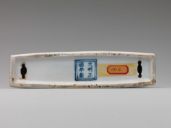It's all about the base
On the base of the brush rest are two holes along the edge. The holes at the base are not uncommon. Holes were customarily placed at the base of porcelain pieces to allow for ventilation during the firing process. This observation points to the fact that our object is made of porcelain by the traditional method of firing. Such ornate openings may have played some role in securing the brush rest to a surface during its working life.
Between the two holes is a blue mark dating the brush rest between 1505 and 1521, the reign of the Ming Emperor Zhengde. It was common practice in sixteenth-century China to place dating marks at the bottom of porcelain pieces.
Another brush rest produced in the same period, currently in the collection of the British Museum, also showcases the Zhengde mark. The mark, which is the same as the one on our object, indicates it was a Zhengde period object. However, the small holes for ventilation are round and less decorative, which confirms the initial suggestion that the elongated opening on our object may have played a dual role.
Before we climb the peaks of this brush rest, the extension below will show you how such a rest sits on a desk.

](https://micrio.thingsthattalk.net/uHwKU/views/max/320x128.jpg)